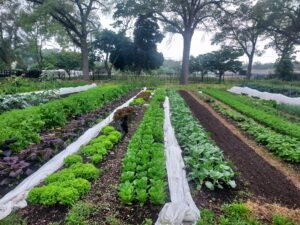Project Overview
Project was cancelled due to staffing changes. The second year of the grant, in part due to instability from turnover. The Farm did not purchase materials or supplies for year two and the final funding was not dispersed.
Commodities
- Miscellaneous: mushrooms
Practices
- Crop Production: cropping systems
- Sustainable Communities: urban agriculture
Proposal summary:
As an urban farm, McLaughlin Grows is severely limited in growing space. We have a no-till high-rotation system that allows us to produce an incredible amount of produce per square foot. However, there are parts of the farm that are not currently productive. This includes areas shaded by large oak trees, fence lines, mulched pathways between beds, and areas around our perennial and season-long crops. As McLaughlin Grows sits in inner city Muskegon, a major food desert, one of our main objectives as an organization is to provide the best variety of fresh healthy food to our community. We feel that this currently unproductive space could be used to further provide a source of nutrition for the community. We are also always looking into how to make our system more sustainable. We feel that utilizing every production opportunity is a big step in the direction of sustainability.
Project objectives from proposal:
4a) SOLUTION
These currently unproductive areas of the farm will be inoculated with mushroom spawn. The shaded areas under the oak trees and fence lines will make an ideal environment for mushrooms to grow. In these areas we will cultivate shade-loving varieties, such as oyster mushrooms and shiitakes. In our mulched pathways and perennial beds, we will inoculate the wood chips with wine cap mushroom spawn. This variety of mushroom can tolerate and even thrive in direct sun, which many of these areas receive. Among our season-long crops, such as kale, collard greens, and swiss chard, we will mulch underneath the established crops with straw. Then, using the lasagna method, we will layer oyster mushroom spawn and straw as substrate. Mushroom harvests will be weighed and recorded. In areas that will get replanted each year, leftover mushroom substrate will be used as food in our on-site vermicompost system. In perennial areas, the fungi will establish healthy mycelium that will benefit our crops and produce fruit year after year. The mushrooms we harvest will be distributed to the community via Community Supported Agriculture (CSA) shares, and through farmers markets. We will be able to teach the many school classes that tour the farm how to integrate mushrooms into their gardens at home, as well as into their diets and the benefits of doing so.
4b) OBJECTIVES
- Maximize the production potential of the farm by growing mushrooms in currently unproductive space.
- Discover the viability of integrating mushrooms into a chemical-free no-till system.
- Provide an additional food group to our community and CSA members.
- Educate the community on growing mushrooms in a sustainable agriculture operation through educational field trips and social media.
- Increase overall soil health.
6. Increase vermicomposting quality and quantity by providing the worms with spent mushroom substrate at the end of each season.